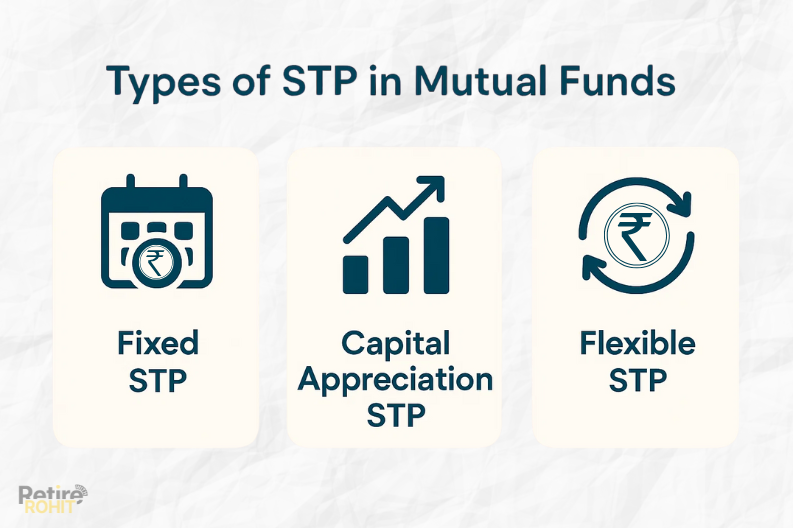What is STP in Mutual Funds?

Investing in mutual funds can sometimes feel like jumping into a swimming pool—you don’t want to dive in all at once, especially if the water (market) is cold (volatile). That’s where STP, or Systematic Transfer Plan, comes into play. It’s like dipping your feet in slowly rather than taking a sudden plunge. Here we will understand about STP in Mutual Fund.
What is STP in Mutual Funds?
STP or Systematic Transfer Plan helps investors move their money gradually from one mutual fund to another, usually from a low-risk debt fund to a high-growth equity fund. This is done at regular intervals, weekly, monthly, quarterly, etc.
Now, imagine you received ₹5 lakhs from a fixed deposit maturity.
- You want to invest in equity mutual funds, but are afraid the market is too high.
- Instead of investing the entire ₹5 lakhs in one go (lump sum), you invest the money in a liquid fund and gradually transfer ₹25,000 every month to an equity fund.
- This way, you reduce market timing risk and benefit from rupee cost averaging.
Let’s take a real-life based example:
- Let’s say the Nifty 50 is near all-time highs in March 2025.
- You have ₹6 lakhs, but you’re scared to invest all at once.
- So, you invest ₹6 lakhs in HDFC Liquid Fund and set up an STP to HDFC Flexi Cap Fund for ₹50,000/month.
| Month | Amount Transferred (₹) | NAV of Flexi Cap Fund | Units Purchased |
| March | ₹50,000 | ₹100 | 500 units |
| April | ₹50,000 | ₹95 | 526.31 units |
| May | ₹50,000 | ₹90 | 555.56 units |
As the NAV drops, you buy more units, benefiting from Rupee Cost Averaging.
Key Features of STP in Mutual Funds
Here are the key features:
Automatic & Systematic Transfers:
- STP automatically moves a fixed or variable amount from one scheme to another at regular intervals.
- No manual effort once it's set up.
- Setting up a standing order to move money from your savings account to your investment account every month.
Flexible Frequency:
You can choose how often the transfers happen:
- Daily
- Weekly
- Monthly
- Quarterly
- Most investors prefer monthly STP for smoother transitions and easier tracking.
Requires the Same AMC (Fund House):
- Both the source (debt fund) and destination (equity fund) must belong to the same mutual fund company.
- For example, the HDFC Liquid Fund to HDFC Flexi Cap Fund, not HDFC Liquid Fund to ICICI Prudential Bluechip Fund.
Minimum Transfer Amount:
- Typically starts from ₹500 to ₹1,000 per transfer, depending on the AMC.
- The total corpus in the source fund should be large enough to sustain the entire STP duration.
Rupee Cost Averaging:
- STP helps you buy more units when prices are low and fewer when prices are high, just like a Systematic Investment Plan (SIP).
- This reduces the risk of entering the market at a bad time.
Money Doesn’t Stay Idle:
- While waiting to be transferred, your money earns returns in a liquid or debt fund (usually 6–7% annually).
- Better than keeping it in a savings account.
Modifiable or Stoppable:
You can stop or modify your STP at any time before completion, depending on the fund house’s rules.
- Add/change the amount
- Change the frequency
- Pause or cancel the STP
Types of STP in Mutual Funds

Image generated with ChatGPT
There are 3 main types of STP based on how and how much money you transfer from one fund to another.
Fixed STP
You transfer a fixed amount at a fixed frequency (weekly, monthly, etc.). This is the simple one. You transfer the same amount every month.
Best For:
- People with a lump sum want to avoid market timing.
- Regular, predictable transfer, no surprises.
For example, you invest ₹6,00,000 in ICICI Liquid Fund, and you set up a Fixed STP of ₹50,000 a month to ICICI Flexi Cap Fund.
| Month | Amount Transferred | Target Fund |
| Jan | ₹50,000 | Flexi Cap |
| Feb | ₹50,000 | Flexi Cap |
| Mar | ₹50,000 | Flexi Cap |
Simple, steady, and predictable.
Capital Appreciation STP
Here, only the gains (profits) made in the source fund are transferred to the target fund. In simple terms, this one is for people who don’t like taking risks. You only transfer the profit, and keep the original amount safe.
Best For:
- Very conservative investors who want to protect their principal.
- Suitable for retirees or those who don’t want to risk their full capital.
For example, you invest ₹5,00,000 in the HDFC Short-Term Debt Fund.
- After 1 month, the value becomes ₹5,05,000.
- Only ₹5,000 (the profit) is transferred to the HDFC Equity Fund.
- Your ₹5,00,000 capital stays safe in the debt fund.
| Month | Fund Value | Profit | Amount Transferred |
| Jan | ₹5,05,000 | ₹5,000 | ₹5,000 |
| Feb | ₹5,10,000 | ₹5,000 | ₹5,000 |
Note: If there’s no gain, nothing gets transferred that month.
Flexible STP
The amount transferred changes every time, based on certain conditions, like:
- Market levels (NAV-based)
- Value of the source fund.
- Your custom logic
In simple terms, this is the smart, moody one. You transfer more money when the market is down, and less when it’s up.
Best For:
- Active investors who like to tweak strategies.
- Situations where you want to invest more when the market falls.
For example, you invest ₹5,00,000 in the SBI Liquid Fund. You set a rule:
- If the NAV of the SBI Bluechip Fund falls, invest ₹50,000.
- If it rises, invest only ₹10,000.
| Month | Blue-chip NAV | Amount Transferred |
| Jan | ₹95 | ₹50,000 |
| Feb | ₹105 | ₹10,000 |
| Mar | ₹92 | ₹50,000 |
You’re being smart, buying more when prices are low.
Tax Treatment of STP
Taxation depends on the type of fund you transfer from (source fund):
When you move from Debt to Equity:
Every transfer is treated as a redemption from a debt fund, so capital gains tax applies.
| Holding Period | Type | Tax Rate |
| < 3 years | Short Term Capital Gain (STCG) | As per your income tax slab |
| > 3 years | Long Term Capital Gain (LTCG) | 20% with indexation |
No Tax on Receiving Equity Fund:
The amount received by the equity fund is not taxed at the time of transfer.
Conclusion
In conclusion, STP is like a money shortcut with brains. It helps you invest smartly without stressing about whether the market is high or low. Right now, when markets are jumping up and down like Virat Kohli’s mood during an IPL match, STP is a great idea. It doesn’t matter if you’re a beginner who just got their first salary or an expert investor with crores in hand. We hope this blog has been helpful to you.


